Most hotspots and WiFi networks use captive portals to enhance customer interaction. In this article, we will give you the best solutions if your network is showing a captive portal warning when browsing or accessing certain programs or HTTP websites. The issue can happen randomly from nowhere and can block you from accessing a site or asking for authentication.
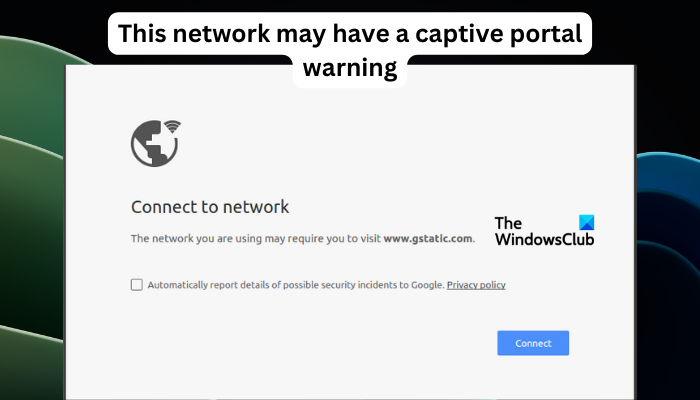
This error redirects you to the default browser on your Chromebook. In most cases, the prompt tells you to return to the host page. This is an annoying error, especially if it persists longer.
What is a network captive portal?
A captive portal is a page that pops up once you connect to a WiFi network, especially if you are a new user. Some people also refer to it as the splash page. It is mostly used by businesses that provide free or paid public WiFi networks.
Captive portals are also used to limit bandwidth, authenticate users behind a firewall, deploy personalized marketing, or restrict internet access for guest wireless clients. However, it can sometimes happen on your normal WiFi hotspots and can be frustrating if you don’t know how to fix the error.
Fix This network may have a captive portal warning
If you get the prompt ‘This network may have a captive portal warning’ when you access wireless internet for the first time, we recommend the following solution to fix the issue successfully:
- Restart your devices and WiFi
- Close all browser tabs and programs
- Update router firmware
- Change DNS settings
- Temporarily disable VPN and proxy
Let us look at these solutions one by one in detail.
1] Restart your devices and WiFi
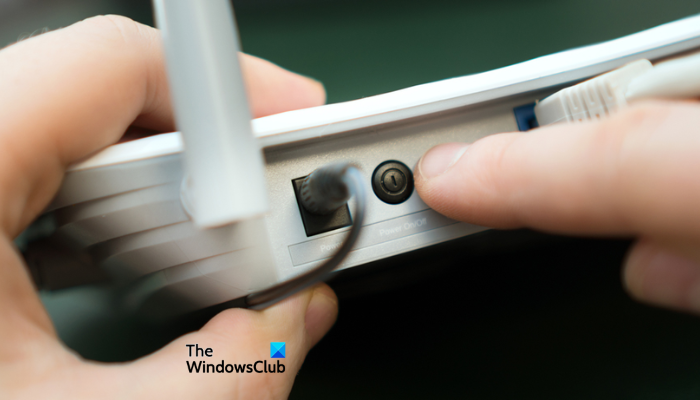
The issue can be temporary, which can be fixed by restarting your PC, router, modem, etc. In most cases, the captive portal warning is a bug or temporary technical issue, and some users have resolved the problem by performing preliminary steps.
If restarting your devices and wireless internet does not resolve the captive warning error, try other solutions below.
2] Close all browser tabs and programs
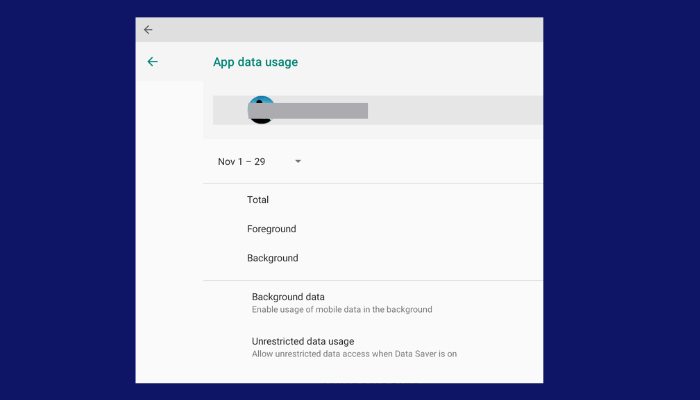
There could be browser issues or apps that interfere with your internet connection, leading to the captive portal warning. To fix the error, do the following:
- Close all browser tabs, and then try again. Only open HTTP websites or web applications. HTTPS sites might cause some issues.
- Close any open or background software that might be preventing you from accessing your wireless connection.
- Disable any recent browser extension for a moment and see if the error is resolved.
If that doesn’t work, explore other solutions below.
3] Update router firmware
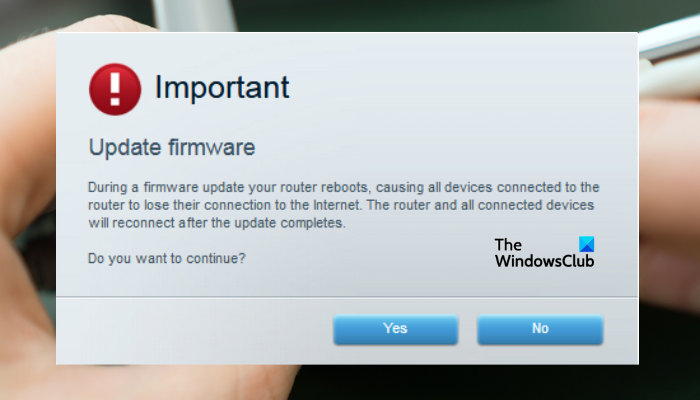
The router firmware might be outdated or not correctly configured, and that is why you have the prompt indicating that your network may have a captive portal warning. To fix this, follow the steps below:
- Use an Ethernet cable to connect the router to your PC.
- Write the router’s IP address on the browser’s address bar and load it.
- Log in as an administrator. If you can’t connect here, you need to contact your ISP.
- Navigate to the Update or Firmware sections and check for any available updates.
- Download, extract the firmware file, and then upload it to your router.
- Finally, restart your computer and see if you are still getting the warning.
Go to the next solution if that doesn’t fix the captive portal warning.
4] Change DNS settings
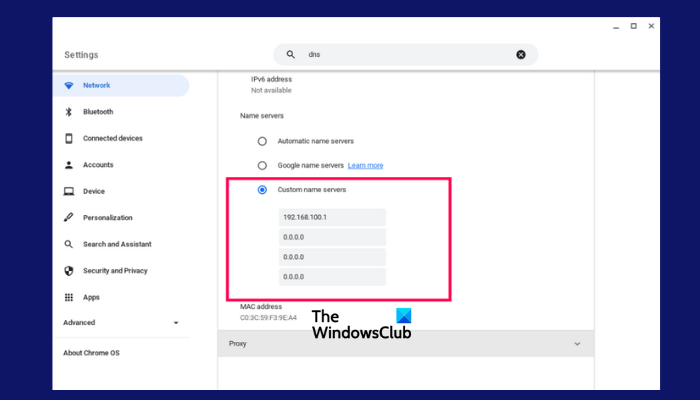
Tweaking your DNS settings can fix the captive portal warning while connecting to your network on your Chromebook. To change the DNS server settings, you can do the following:
- Open Settings and go to Network.
- Select the WiFi network you’re connected to
- Select the Network collapsible tab
- Scroll down to Name servers
- Click the drop-down menu to the right of Name servers
- Select Google name servers to use Google’s Public DNS servers
- Select Custom name servers to provide your own addresses
Check if the warning is still appearing. If so, try the next fix.
5] Temporarily disable VPN and proxy
Some third-party VPN software and proxies can interfere with your internet connection. You can temporarily disable your VPN. The process depends on which VPN you are using. You can uninstall it for a moment and then reinstall it later if it’s not the cause of the captive portal warning on your network.
To disable the VPN on your computer, follow the steps below:
- Go to Settings > Network
- Choose VPN
- Click the VPN connection to toggle it off
According to Google, consumer-owned Chromebooks don’t have a proxy. However, if your Chromebook or account is managed by a school or organization, you can try these steps to disable proxy in Google Chrome:
- Open Google Chrome
- Click the three dots in the top-right corner
- Click Settings
- Scroll down and click Advanced
- Under System, toggle off Use a proxy server
You can also open your computer’s proxy settings by clicking Open your computer’s proxy settings under System.
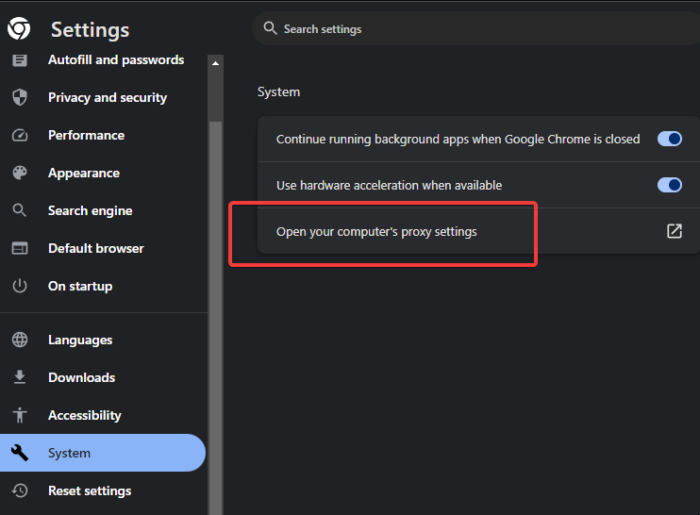
Chrome doesn’t have in-app proxy server settings, so you’ll be redirected to your operating system’s native proxy settings.
Pro tip: It is good to note that in some cases you need to go to the login or authentication page to use the internet, especially if it’s public WiFi or the provider is protecting payment or other crucial websites.
We hope something here works out for you.
Read: Enable or disable Firefox Network Captive Portal Service
What does it mean when a captive portal is detected?
If the captive portal is detected, it means that your device has detected a captive portal on your network. It may require you to enter your login details or user agreement before you can actually access that particular wireless connection. This is common in public WiFi in public places like hotels, streets, etc.
Read: Enable or disable ‘Use a web service to help resolve navigation errors’ in Microsoft Edge
How do I turn off captive portal network?
If you decide to turn off the captive portal on your network, go to the router’s web page and navigate to Network or Wireless settings. Here, look for the option named a captive portal or something similar. If the option is turned on, ensure that you turn it off. The last step is to save the changes you made and then restart your router by switching it off and then on.